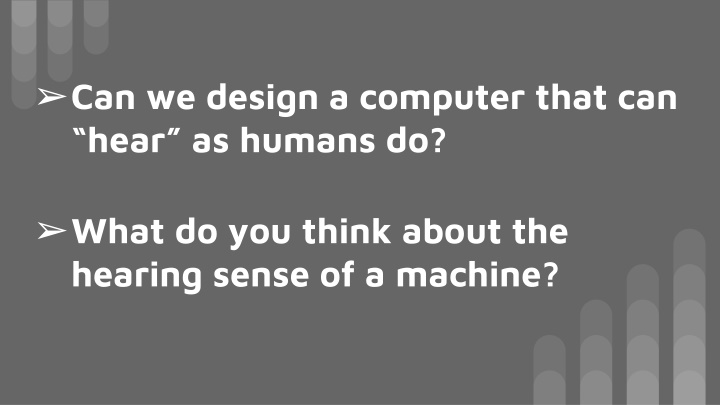
Advancements in Machine Hearing for Instrument Identification in Music
Researchers are exploring the ability to design computers with hearing capabilities akin to humans for identifying musical instruments in polyphonic music signals. Traditional methods had limited success, but recent advancements in deep learning approaches using CNN have shown promise. The focus is on improving accuracy and expanding recognition capabilities to include real-world scenarios with external disturbances. Datasets like Medley DB and Mixing Secrets are being utilized for further research and development in this field.
Uploaded on | 2 Views
Download Presentation

Please find below an Image/Link to download the presentation.
The content on the website is provided AS IS for your information and personal use only. It may not be sold, licensed, or shared on other websites without obtaining consent from the author. If you encounter any issues during the download, it is possible that the publisher has removed the file from their server.
You are allowed to download the files provided on this website for personal or commercial use, subject to the condition that they are used lawfully. All files are the property of their respective owners.
The content on the website is provided AS IS for your information and personal use only. It may not be sold, licensed, or shared on other websites without obtaining consent from the author.
E N D
Presentation Transcript
Can we design a computer that can hear as humans do? What do you think about the hearing sense of a machine?
Instruments Identification for Real World Music Research by P. Thamilvaanan(2015/CSC/014) Supervisor Dr. E. Y. A. Charles
Demand of this work The identification of the instruments playing in a polyphonic music signal is an important and unsolved problem in MIR (Music Information Retrieval). Recognizing musical instruments is the major issue in Music transcription of Digital Audio Processing. Music genres depend on instruments which are used in a music. (typical jazz musics are composed of piano or guitar, double bass and drums and a wind instrument or a singer)
Previous Researches Before 2003 : There were several researches in this area but only for Isolated notes and Monophonic music with 70% average accuracy. 2003 - 2015 : In this period people started researching on this field with Polyphonic music. They used traditional methods to solve this problem. However they got less accuracy like below 50% and also the number of instruments were limited. After 2015 : These days researchers came up with Deep learning approaches using CNN to identify polyphonic music. This approach is better comparing to other traditional approaches but it still lack enough accuracy.
Research Improvement target With having research already started on this topic with Polyphonic music but only with the instruments sound i.e. without external disturbances and also with low accuracy I am planning to improve the accuracy with better improvement and using of decision model. And also if possible I will try to improve the recognition of instrument in polyphonic music along with the presence of external disturbances which is the real-world scenario.
Datasets for my future work Medley DB (contains 330 multi-tracks) Mixing Secrets (contains 258 multi-tracks)
References Jana Eggink and Guy J. Brown, A missing feature approach to instrument identification in polyphonic music, in IEEE International Conference on Acoustics, Speech and Signal Processing (ICASSP), Hong Kong, April 2003, pp. 553 556. S. Essid, G. Richard, and B. David, Instrument recognition in polyphonic music, in Proc. ICASSP, Philadelphia, USA, 2005. T. Heittola, A. Klapuri, and T. Virtanen, Musical instrument recognition in polyphonic audio using source-filter model for sound separation, in Proc. 10th Int. Soc. for Music Inf. Retrieval Conf. (ISMIR), Kobe, Japan, 2009, pp. 327 332. Emre Cakir, Toni Heittola, Heikki Huttunen, and Tuomas Virtanen. Polyphonic sound event detection using multi label deep neural networks. In Proc. International Joint Conference on Neural Networks (IJCNN), pages 1 7, 2015.
